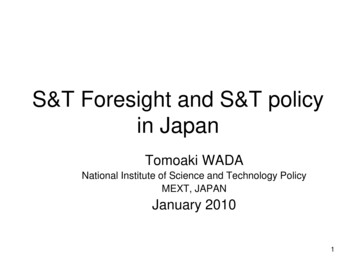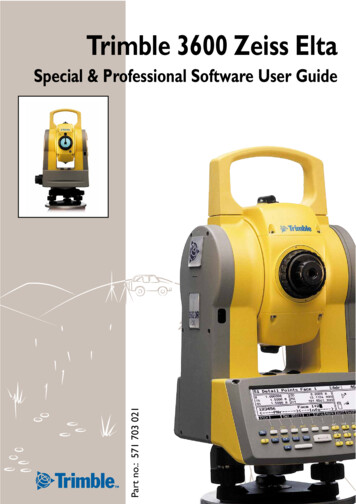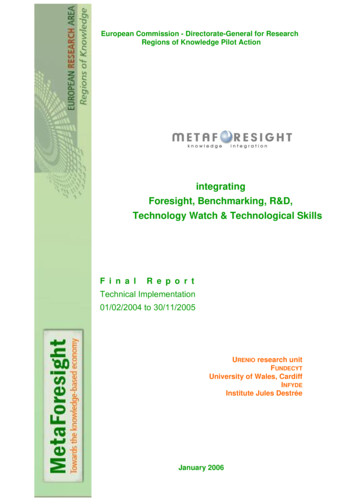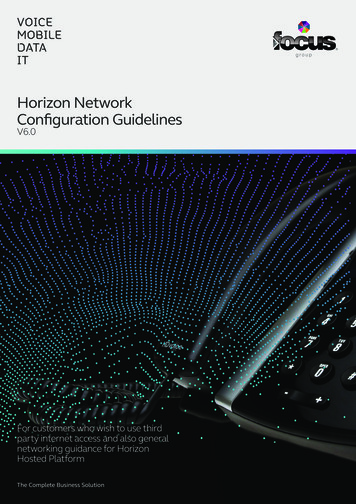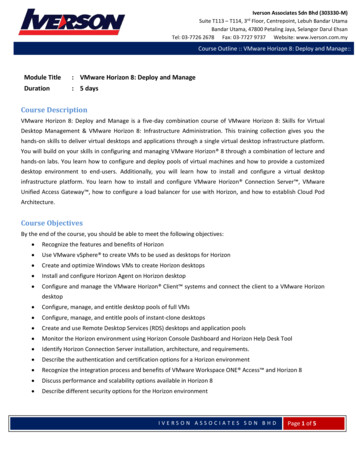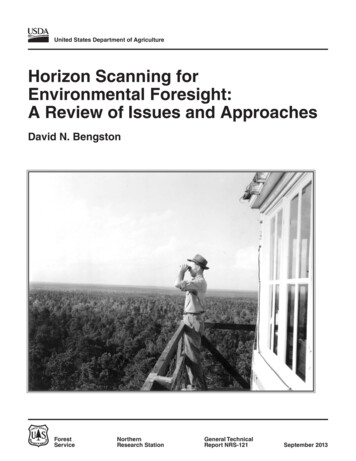
Transcription
United States Department of AgricultureHorizon Scanning forEnvironmental Foresight:A Review of Issues and ApproachesDavid N. BengstonForestServiceNorthernResearch StationGeneral TechnicalReport NRS-121September 2013
AbstractNatural resource management organizations carry out a range of activities to examinepossible future conditions and trends as part of their planning process, but the distinctapproach of formal horizon scanning is often a missing component of strategic thinkingand strategy development in these organizations. Horizon scanning is a process for findingand interpreting early indications of change in the external environment of an organizationor field. Effective horizon scanning serves as an early warning system to identify potentialopportunities and threats, enable decisionmakers to plan accordingly and take timelyaction, and foster a culture of foresight throughout an organization. This paper reviewsand discusses the key items needed to create an effective horizon scanning system:conceptual frameworks, organizational approaches, design principles, techniques to improveeffectiveness, and techniques for analyzing and interpreting scanning results.The AuthorDAVID N. BENGSTON is a research social scientist with the U.S. Forest Service, NorthernResearch Station, 1992 Folwell Avenue, St. Paul, MN 55108, dbengston@fs.fed.us.Cover PhotoForest ranger Bryce Ledford uses binoculars at Yellowpin lookout in Sabine National Forest,Texas. Undated photo used with permission of the Forest History Society, Durham, NC.Manuscript received for publication 5 April 2013Published by:For additional copies:U.S. FOREST SERVICE11 CAMPUS BLVD SUITE 200NEWTOWN SQUARE PA 19073U.S. Forest ServicePublications Distribution359 Main RoadDelaware, OH 43015-8640Fax: 740-368-0152Email: nrspubs@fs.fed.usSeptember 2013Visit our homepage at: http://www.nrs.fs.fed.us/
INTRODUCTIONNatural resource managers and policy makers arecontinually working toward a desired future within thecontext of rapid and turbulent change in the externalenvironment in which they operate. To be effectivein a complex and changing world, decisionmakersmust look ahead to anticipate emerging trends, issues,opportunities, and threats. They need to develop andapply strategic foresight, i.e., “the ability to create andmaintain a high-quality, coherent and functional forwardview and to use the insights arising in organisationallyuseful ways; for example: to detect adverse conditions,guide policy, shape strategy” (Slaughter 1999b: 287).Natural resource management agencies work to gainstrategic foresight by many means. For example, theU.S. Department of Agriculture, Forest Service (USFS)carries out the Resources Planning Act Assessment every10 years to provide a detailed look at current conditionsand trends for the Nation’s renewable forest resources.National forest planners are required by the 2012 USFSPlanning Rule to “rapidly evaluate existing informationabout relevant ecological, economic, and socialconditions, trends and sustainability,” and to “considerand evaluate existing and possible future conditions andtrends of the plan area” (USFS 2012: 21262).These and many other existing activities for developingforesight are essential. But they may not be sufficientto meet the need for high-level strategic foresight inthe present era of increasingly rapid, complex, andsurprising change. Horizon scanning is one approachto help policy makers develop and maintain the broadand externally focused forward view they need. Alsoknown as environmental scanning, external scanning,and strategic scanning, horizon scanning may be definedas “the acquisition and use of information about events,trends and relationships in an organization’s externalenvironment, the knowledge of which would assistmanagement in planning the organization’s future courseof action” (Choo 2002: 84). Characteristics of horizonscanning that distinguish it from the typical activitiesto survey future conditions and trends carried out byforest planners include its emphasis on “weak signals”(early indicators of potential change), comprehensivescanning of all sectors, an emphasis on external trendsand developments, and the inclusion of possible wildcards (low-probability, high-impact events). Horizonscanning encompasses a wide range of techniques andorganizational approaches for identifying and interpretingthe potential implications of weak signals of change.Ideally, horizon scanning serves as an early warningsystem to identify potential threats and opportunities.The goals are to find nascent indications of importantfuture developments so decisionmakers can planaccordingly and take timely action, and more broadly tofoster a culture of foresight in the organization.Techniques for systematically gathering and analyzinginformation about emerging external issues and trendswere originally devised by military intelligence officers togain insights into new developments in enemy countries(Cornish 2004). Scanning has long been standardpractice in the military, the intelligence community,and the business world and is a core method in futuresresearch. In recent years, horizon scanning has beenused in a growing number of fields in the public sector,such as human health (Douw and Vondeling 2006) andeducation (Munck and McConnell 2009). But the useof formal horizon scanning in natural resources and theenvironment has been limited. Rare examples includescanning exercises related to biodiversity (Sutherlandet al. 2008) and global conservation issues (Sutherlandet al. 2010), and the U.S. Army Environmental PolicyInstitute’s futures scanning on environmental issues(U.S. Army Environmental Policy Institute, n.d.). TheNational Advisory Council for Environmental Policy andTechnology recommended that the U.S. EnvironmentalProtection Agency (EPA) create an ongoing,institutionalized scanning system (U.S. EPA 2002), butthis recommendation has not been implemented. Thoughwidely used in many fields, horizon scanning remainsan underused tool for natural resource planning anddecisionmaking (Sutherland and Woodroof 2009).Although formal horizon scanning is uncommon inenvironmental and natural resource managementorganizations, all decisionmakers scan the externalenvironment. Some scan passively and informally,keeping their antennae up and waiting to receive outsidesignals of change that may be significant. Others scanactively and formally. The research literature on scanning1
Figure 1.—Conceptual model of a horizon scanning system. (Source: Gordon and Glenn 2009).in business clearly shows the value of active and formalscanning (Choo 2002). This paper introduces this topicto natural resource planners, managers, and policymakers, and reviews key considerations needed to createan effective horizon scanning system. The followingsection reviews two conceptual models of horizonscanning systems to indicate the basic elements andstructure. This review is followed by discussions of theorganizational approaches and design principles that needto be considered in different organizational contexts.Techniques to improve the effectiveness of scanning andto analyze and interpret scanning results are described insubsequent sections.CONCEPTUAL MODELS OF HORIZONSCANNING SYSTEMSMany different horizon scanning systems have beendeveloped by futurists, business scholars, and others.These systems encompass a wide range of approaches andelements. Most include at least three main components:scanning, analysis, and interaction with decisionmakers.In this section, I describe the broad outlines of twotypical horizon scanning systems, one developed by2futurists Gordon and Glenn (2009) and the other bybusiness researchers Day and Schoemaker (2006).Figure 1 depicts a generic horizon scanning systemproposed by the Millennium Project, an independentglobal futures research think tank (Gordon and Glenn2009). The scanning component usually consists ofa team effort to examine diverse information sourcesto identify potential signals of change and emergingtrends, referred to as scanning hits. Examples of scanninghits could include a breakthrough in nanotechnologyreported in the research literature, a surge in permitapplications for sand mining for hydraulic fracturing in aregion, or a decline in participation in outdoor recreationactivities among youth. A few common informationsources are shown at the top of Figure 1, but a 1largenumber of diverse sources should be examined.The analysis and synthesis component involvesidentifying potential consequences of individual scanninghits, as well as synthesizing multiple trends or weaksignals of change and looking at possible big-pictureimplications. A variety of techniques may be used to
Figure 2.—Conceptual model of horizon scanning as a learning process.(Source: Day and Schoemaker 2006: 192).facilitate analysis and synthesis of scanning hits (see thesection below on techniques for analyzing, synthesizing,and interpreting). Information about raw scanning hitsand the results of analysis and synthesis are entered intoan interactive database or collective intelligence systemthat can be searched for keywords to identify patternsand generate reports on topics of interest. This database ismade accessible to managers and policy makers in severalways, such as summary pages, emails of latest scanninghits, and the capability to search the database. The ideais to give decisionmakers a window into the system.Finally, interaction with and feedback from managementis a key element for scanning systems, so that (1) thesystem “learns” how to produce information that ismost relevant to decisionmakers and (2) decisionmakersunderstand the implications of unfamiliar trends anddevelopments.To facilitate the various stages in Gordon and Glenn’s(2009) scanning system, they developed a template tosystematically collect information about each scanninghit (i.e., an emerging trend or development of interest).The template includes the following fields for each item:(1) category or domain it falls in (e.g., technological,economic, environmental, or social), (2) leading indicator(i.e., what would indicate change in this scanning hit?),(3) source of the information and how to access it, (4)other comments about the scanning hit, (5) significance,importance, or possible consequences of the item, (6)current status, (7) actors involved in or affecting the item,and (8) date entered and name of scanner entering theitem. Bishop (2009) presents a more detailed templatedeveloped by futurist Wayne Pethrick that includessubjective ratings of the impact, plausibility, novelty, andtimeliness of each scanning hit.A more detailed horizon scanning process fromthe business world is summarized in Figure 2 (Dayand Schoemaker 2006). This model is grounded inorganizational learning theory and consists of five stages:scoping, scanning, interpreting, probing/acting, andfeedback/adjusting. Scoping is the process of defininghow broadly an organization should scan. If the scopeis too narrow, the organization risks being broadsidedby external surprises; if the scope is too broad, there isa risk of being overwhelmed by unimportant signals.Day and Schoemaker (2006: 32-47) present a set ofguiding questions to strike the right balance in scoping.In general, greater uncertainty in an organization’senvironment requires a broader scope. Given anappropriate scope, scanning is the process of searching foremerging trends and issues, and should include a balanceof exploratory scanning (searching broadly in unfamiliarareas to provide a big-picture view) and “exploitation”scanning (searching in greater depth within well-definedor familiar domains). Interpreting involves developinghypotheses about the meaning of signals identified byscanning. Day and Schoemaker note that interpretingis strongly affected by incomplete and narrow framesof thinking. Confirmation bias—the tendency to favorinformation that confirms our existing beliefs (Nickerson1998)—also affects our ability to accurately interpret themeaning of scanning hits. Therefore, a shift or2 expansionof our individual or organizational mental models may berequired to appreciate potential threats or opportunities(Barker 1992).Probing and acting is about responding to the weaksignals and their anticipated implications. There arethree main approaches to responding: watch and wait (apassive approach that may be appropriate when stakes3
are low or there is high uncertainty), probe and learn(a more proactive response to learn more when thecost of inaction is higher), or believe and lead (a strongcommitment to respond when a convergence of signalsindicates that a threat is imminent or an opportunityis very promising). Finally, feedback and adjusting isthe process of obtaining feedback on actions related toweak signals and making appropriate adjustments tothe organization’s understanding of its environment,including its mental models.Other models of horizon scanning have been proposed,but they are fundamentally variations on the basicmodels. For example, futurists Slaughter (1999a), Voros(2001), and Hines (2003) focus on the importanceof scanning a broad range of sources and draw on thework of integral philosopher Ken Wilber to achieve thisbreadth. The essence of this “integral futures” approachis a four-quadrant matrix that identifies four spheres ofsocial life that should be incorporated in scanning toensure the inclusion of both objective phenomena thatare measurable (e.g., from the scientific and social realms)and subjective phenomena that must be interpreted (e.g.,from the realms of art and morality).ORGANIZATIONAL APPROACHESHorizon scanning systems have been designed for manydifferent types of organizations to accomplish an array ofpurposes and have used diverse approaches. They rangefrom systems that provide a one-time or periodic scanin large corporations based mainly on the insights of topleaders, to continuous scanning processes that are tailoredfor public sector agencies and that use a participatoryapproach. Some scanning systems use a small team offull-time scanners, whereas others enlist many parttime scanners throughout an organization. Scanningmay be focused on a specific set of priority issues, orit may involve broad scoping of the entire externalenvironment. The diversity of approaches suggests thatscanning systems should be designed to fit the contextand information needs of decisionmakers in a particularorganization. Yasai-Ardekani and Nystrom (1996)show that organizations with effective scanning systemsalign their approach with their specific organizationalcontext. This section briefly describes the three main4organizational approaches for horizon scanning activities:outsourcing to consultants, an in-house dedicatedscanning team, and an in-house core team workingwith a network of part-time scanners throughout theorganization.Outsourcing to ConsultantsOutsourcing scanning activities to consultants is acommon approach and a large number of firms offerscanning services customized to clients’ informationneeds. Organizations may purchase scanning servicesand analyses, or simply subscribe to scanning newslettersthat are more or less tailored to their needs (Lesca andCaron-Fasan 2008). Using the expertise of consultantsmay be a quick and effective way to initiate scanning,and outside partners may provide innovative perspectivesthat can be difficult to obtain from internal efforts. ButDay and Schoemaker (2005) note that organizationsneed to work hard to ensure that the scanning insightsof outside consultants are relevant and incorporated intostrategic planning and decisionmaking. A small in-houseteam typically works with the consultants to help ensurerelevance, interpret scanning hits, and communicatewith executives. Choudhury and Sampler (1997)suggest that scanning should be outsourced only wheninformation specificity for the area being scanned is low,i.e., information can be acquired by individuals withoutspecific knowledge of the area.Dedicated In-house TeamA second approach is to form a dedicated in-housescanning team whose sole job is to search for, analyze,and communicate information about trends in theexternal environment. Dedicated scanning teams arewidely used in corporations of all sizes (Brown 2007,Choo 2002). Such teams are sometimes referred to asa “crow’s nest” because they function like the lookoutin a ship, signaling information about objects on thehorizon—both opportunities and potential threats—tothe captain and crew. The size of these teams variesconsiderably depending on the size of the organization,from two or three members up to dozens. To beeffective, full-time scanning teams must work to avoidthe trap of becoming isolated from decisionmakers (Dayand Schoemaker 2005). A potential drawback of this
organizational approach—as well as outsourcing—is thatlimiting scanning activities and responsibilities to a selectgroup can make it more challenging to foster a culture offoresight throughout an organization.Core Team with NetworkThe third main approach to organizing horizon scanningactivities is more broadly participatory: a small inhouse scanning team (or an individual) working witha much larger network of part-time scanners. Choo(1999), Day and Schoemaker (2005), and others havemade the case that scanning is more effective andproduces richer insights for decisionmaking whenit is a widely distributed activity with many peopleparticipating. A participatory approach is based on theassumption that everyone in an organization, not justa designated scanning team or top leaders, may havevalid and important insights about the changing externalenvironment, and a scanning system should thereforefacilitate gathering insights from as many people with asdiverse backgrounds as possible. The core scanning unitmay consist of a single half-time coordinator or a teamof several members, and is supported by a network ofpeople throughout the organization who spend a smallpart of their time engaged in scanning (Conference Boardof Canada 2008). The scanning network may consistof volunteers or purposely selected individuals formallyassigned to the duty. In public sector agencies, outsidestakeholders representing diverse perspectives could berecruited and trained to actively contribute to scanning.Other ApproachesThere are many variations on these three approaches tostructure scanning activities, and they may be combinedin various ways: Outside consultants often design andset up in-house scanning systems, or a consultant maytrain an internal scanning team. Additional approaches toorganize periodic or one-time scanning efforts typicallyinvolve group processes relying on external experts orinternal leaders. For example, the Quick EnvironmentalScanning Technique (QUEST) was developed foruse in relatively large organizations (Nanus 1982).An underlying assumption is that members of the topmanagement team have valid and insightful views ofthe changing external environment but rarely articulateand share these views. The QUEST process provides asystematic framework to bring these views to light inorder to aggregate, examine, test, and put them to use forstrategic planning and decisionmaking. By tapping intotop leaders’ collective knowledge, QUEST also engagesthese leaders in the scanning process and secures their“buy-in” of the results (Slaughter 1990).The QUEST process involves four main phases. Firstis the preparation phase, which focuses on creationof an initial notebook containing information aboutmajor trends and relevant issues in the organization’sfield and the external environment. The information isdrawn from a variety of readily available sources suchas trade association and government publications andrecent articles speculating about the future of the field,and the notebook is distributed to a group of 10-15top executives and managers from the organization.The second phase is a 1-day scanning workshopspent in carefully structured discussion of importantissues that may affect the future of the organization.Scenario development is the third phase, in whichthe QUEST facilitator prepares a report analyzing allof the information generated in the preceding phase.The report also includes development of three to fivescenarios describing possible future environments theorganization may find itself in based on the major themesthat emerged during the 1-day workshop. The report isdistributed to participants 1 week before the final phase,a half-day strategic options identification workshop.Based on the report, participants identify and rankstrategic options to deal with the changing organizationalenvironment. Strategic planning teams are also formed tofollow up on development of the high-priority strategies.DESIGN PRINCIPLESRegardless of which organizational approach is used,additional design issues must be addressed to structurescanning activities, including the degree of focus;continuous or periodic scanning; the time horizon forscanning hits; and the importance of having a diversescanning team, information sources, and products.These design principles are discussed in the followingsubsections.5
Focused or Broad ScanningDay and Schoemaker (2006) emphasize that scanningactivities should begin with scoping to determine howbroadly to search. Horizon scanning sometimes focuseson a particular domain considered to be most important,such as emerging technologies (Douw and Vondeling2006), competitive or competitor intelligence (Ghoshaland Westney 1991), or a particular issue or set of issues.But scanning that is too focused will fail to detect signalsof change in other domains, raising the risk of beingblindsided by unexpected developments (Harris 2002).The other end of the scoping spectrum is to make thescope of horizon scanning as comprehensive as possible,a full-circle sweep to detect signals of change anywherein the external environment. Futurists generally takethis comprehensive or high-level approach to scanning(e.g., Hines 2003, Slaughter 1999a) because they havefound that changes in seemingly unrelated external areascan have unexpected and profound effects. For example,the automobile had a transformative effect on the use ofpublic lands in the 20th century, including fostering thecreation of the wilderness system as a way to preservelands from widespread road building (Sutter 2002). Thepotential downside of comprehensive scanning is therisk of overwhelming decisionmakers with unimportantsignals. Therefore, careful analysis, synthesis, andinterpretation are essential if a broad approach is taken.A mixed strategy of both broad, high-level scanning andlow-level scanning that homes in on specific areas andanalyzes them in detail may be optimal (Choo 2002).Several trend classification systems have been used tofacilitate scanning broadly across every sector of theexternal environment. For example, a widely usedclassification system features six broad categories with theacronym DEGEST: demography, economy, government,environment, society/culture, and technology (Kotlerand Keller 2008). Another commonly used acronymfor sectors in the macroenvironment is STEEP: social,technological, economic, environmental, and political(Morrison 1992). Trend classifications such as theseare useful starting points to ensure scanning a widerange of topics, but organizations often build onstandard lists and develop their own set of categoriesimportant to their unique context and information6needs. For example, horizon scanning in corporationsoften includes scanning for trends related to customers,suppliers, and competition (Choo 2002). The publicsector equivalent would be to include the full range of anagency’s stakeholders—e.g., how their attitudes, beliefs,values, demographic characteristics, and views of policyand management issues are changing and what thesechanges might imply—so the agency can be responsive tostakeholders’ needs in the future.Continuous or Periodic ScanningMany horizon scanning systems are designed to provideongoing, continuously updated information about thechanging external environment, bringing weak signals ofchange to the attention of decisionmakers as soon as theyare spotted on the horizon. Some professional scannersand futurists believe a continuous approach is essentialto avoid static scans that are unresponsive and quicklybecome outdated (Conference Board of Canada 2008).Other scanning efforts provide periodic assessments ofmajor emerging trends and driving forces of change.Examples of public and nonprofit sector periodic scansare the United Way of America’s (1992) “What LiesAhead” reports produced every 2 years from 1980through 1992, the Millennium Project’s annual “Stateof the Future” report (Glenn et al. 2012), the UnitedNations Environment Programme’s biennial reportson emerging environmental issues (United NationsEnvironment Programme 2012), and the U.S. CentralIntelligence Agency’s quadrennial assessments of globaltrends (National Intelligence Council 2012). Whichapproach is more appropriate—continuous scanning ofweak signals, periodic assessments of major trends, orsome blend—depends on the purpose of the scanningsystem, users’ information needs, and the degree ofturbulence in an organization’s external environment.Time HorizonScanning systems sometimes incorporate multiple timehorizons into the scanning framework to help plannersand decisionmakers sort out and deal with a large numberof trends and issues that may emerge or have an impact atdifferent points in the future. For example, Brown (2007)describes three time horizons for different types of trends:Horizon 1 (“now”) includes trends and driving forces that
are having an impact on an organization today, horizon 2(“next”) consists of emerging trends that are expected tohave an impact in the near future, and horizon 3 (“new”)applies to trends and driving forces that may shape anorganization’s environment in the longer term. The exactdefinitions of horizons 1, 2, and 3 are variable and willdepend on the pace of internal and external change. Inits quarterly horizon scans, the Centre for EnvironmentalRisks and Futures (CERF) at Cranfield University sortsscanning hits into three time horizons: 1-3 years, 3-10years, and 10 years (CERF 2012).Diverse Scanning TeamIncluding diverse perspectives on scanning teams iswidely viewed as essential for success. Scanning teammembers are typically limited in their ability to scaneffectively by their disciplinary backgrounds, frames ofreference, and other personal factors. Specialists tendto see what they are trained to see, a phenomenon thatWeiner and Brown (2005: 2) have called “educatedincapacity.” This limitation poses a basic challengefor horizon scanning: how to best break out of theparadigms and ways of thinking that limit our perceptionof potentially significant trends and developments,especially in unfamiliar areas. To help overcome theseblinders, scanning teams—whether made up of a fewfull-time scanners or many part-timers—need to be asheterogeneous as possible, with diverse backgrounds,perspectives, and experiences (Morrison and Wilson1997). Page (2007) documents that complex problemsare solved more effectively with diverse teams than bythe best individual experts. To increase diversity andeffectiveness, Day and Schoemaker (2005) suggest thatscanning teams include an organization’s maverickemployees – individuals who tend to reject conventionalwisdom and think outside-the-box. The importance ofdiverse perspectives on scanning teams implies the needto include diverse stakeholders in public agency scanningefforts.Diverse Information SourcesScanning a wide range of information sources has alsobeen shown to be critical for success. Choo (2002)recommends including both human and online (ortextual) categories of information. Human sourcesshould include individuals who are making the futureor have their finger on the pulse of change, such asscientists and researchers, futurists, innovative colleagues,consultants, government officials, reporters and othermedia representatives, artists, and community leaders.Identifying forward-looking individuals across manydomains is a challenging but crucial task in developinga network of human sources. Hiltunen (2008) foundthat human sources were ranked the most useful acrossall domain areas in a survey in which 121 futuristswere asked about the best sources for identifying weaksignals of change. Online sources include the Webpages of organizations and individuals, electronicdatabases, blogs, podcasts, discussion groups, and emailnewsletters, as well as traditional textual informationsources such as academic and scientific journals, popularscience and other periodicals, books, newspapers,fringe or underground press, doctoral dissertations, andgovernment and non-profit sector reports.Regardless of whether information sources are human oronline, Schwartz (1996) suggests scanning nontraditionalsources and seeking out potential trends on the edges ofsociety rather than the mainstream. Some professionalscanners recommend including speculative fiction,poetry, film, music, and art to develop an awareness ofdeeper cultural currents and changes in society (Coote2012). Schwartz’s (1996) chapter on “informationhunting and gathering” is filled with tips for searchingout innovative thinkers and sources of information aboutchange, such as reading broadly outside your specialtyand field, contacting the authors of challenging articlesand books, cultivating relationships with people withwhom you disagree but can talk cordially, and immersingyourself in unfamiliar and challenging environments andcultures through travel.Diverse ProductsScanning may generate a variety of products, fromcontinuously updated online databases to lengthyperiodic reports. The timeframe for decisionmakingtypically determines the most appropriate way ofdelivering scanning results. Regular electronic newslettersor concise periodic reports are viewed as
appropriate scope, scanning is the process of searching for emerging trends and issues, and should include a balance of exploratory scanning (searching broadly in unfamiliar areas to provide a big-picture view) and "exploitation" scanning (searching in greater depth within well-defined or familiar domains). Interpreting involves developing
